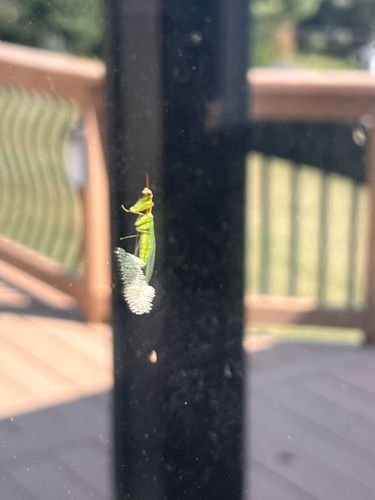Green Lacewing (specifically a female laying eggs)
Scientific Name: Chrysoperla spp. (or similar genus within Chrysopidae)
Order & Family: Order: Neuroptera, Family: Chrysopidae
Size: Adults typically 10-25 mm (0.4-1.0 inch) in length with a wingspan of 15-30 mm (0.6-1.2 inches).

Natural Habitat
Gardens, fields, agricultural areas, woodlands, and urban landscapes. Often found on foliage of plants.
Diet & Feeding
Adults feed on nectar, pollen, and honeydew, though some species are predatory. Larvae (known as aphid lions) are voracious predators, primarily feeding on aphids, but also other soft-bodied insects like mealybugs, thrips, mites, and insect eggs.
Behavior Patterns
Adult green lacewings are nocturnal and attracted to lights. Females lay their eggs individually on slender stalks, often on the underside of leaves or, as seen here, on vertical surfaces. This behavior is thought to protect the eggs from predators, including other lacewing larvae. The larvae are highly predatory and move actively across plants in search of prey. They undergo complete metamorphosis.
Risks & Benefits
Benefits: Green lacewings are highly beneficial insects, particularly their larvae which are important natural enemies of many agricultural and garden pests. They are often used in biological pest control programs. Risks: No known risks to humans. They do not bite or sting and are not considered pests themselves.
Identified on: 9/17/2025